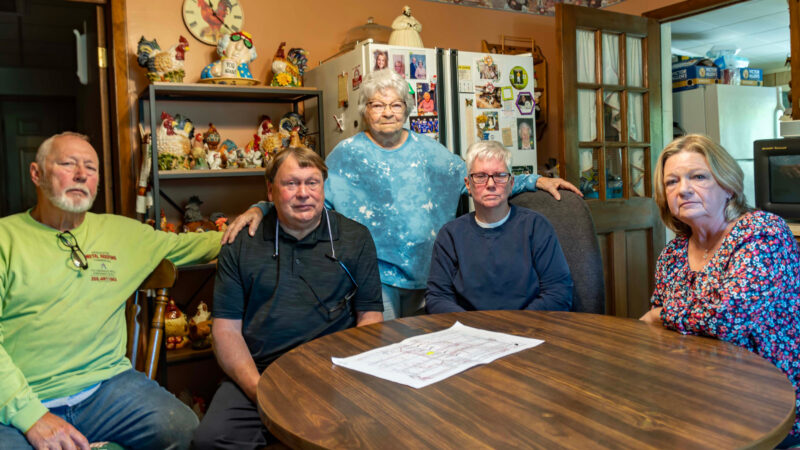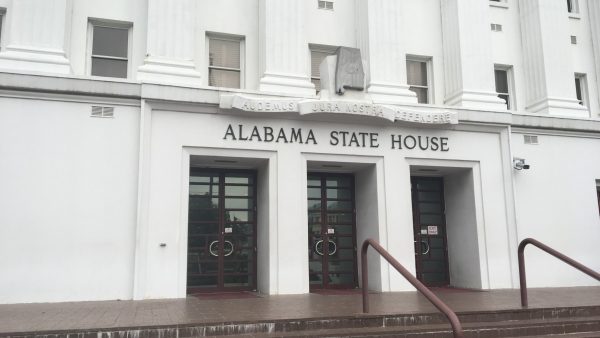MASS Ensemble’s Earth Harp
Carnegie Hall, the Sydney Opera House, the Alys Stephens Center. These are places you go to see music performed. But what happens when a building becomes the instrument?
Noon is a pretty hectic time around the UAB campus. Everyone’s in a rush to get to class or to lunch. So, it’s bit odd to see people just sitting on the grass and hanging out.But that was the case on Tuesday, in front of the Alys Stephens Center.
‘Hey there, do you know what that is? It’s an outdoor earth harp show.’
Susan Spaulding read about the performance in the paper, so she thought she’d come check it out. In a plaza, there’s a raised platform, with a dozen or so strings going up to the top of the building. The strings are spaghetti thin. Stand in the right place, and you can’t see them at all. But Spaulding wonders what it sounds like, and how do you play it?
‘That right there looks like he’s going to stand behind it and play it like a piano or something. But that wouldn’t be a harp, that would be an outdoor piano.’
The answer comes soon enough, as the performance gets underway.
Two members of the MASS Ensemble stand in between the wires. Wearing cotton gloves, they gently tug and pull on the strings. It’s like a watching a game of tug of war that no one wins. The friction they create is what makes the sound.
William Close is founder of the MASS Ensemble. He’s invented over 100 musical instruments.
‘I actually mounted a resonating chamber to one side of a valley and ran strings a thousand feet across to the other side. So, it turned the valley into a giant harp.’
Though the Earth Harp started with natural landmarks, Close says he became fascinated with the possibility of attaching the instrument to man-made structures.
‘The architecture side came from a quote from Frank Lloyd Wright, who actually got it from Goethe, but anyway. The quote is, ‘architecture is frozen music.’ So, the idea was to string the architecture and pull the music out of it.’
MASS has pulled the music out of buildings like Coliseum in Rome, and Seattle’s Space Needle. Buildings are full of materials of that make sound-glass, wood, metal. MASS Ensemble’s Andrea Brook says the Earth Harp is meant to make those materials sing.
‘One time we did this guerilla stringing of a building that was in construction. And we strung just the metal framing, just one of the metal frames. And the entire metal framing sang. So, if you’ve got resonating, if you got air, you’ve got a lot more opportunities for resonance to take place.’
The Alys Stephens Center probably won’t sing. It’s mostly brick and concrete-those are materials that absorb sound. Distance and height effect what the instrument can do, too. The taller the building, the more range the Earth Harp has. Here at the Alys Stephens Center, the strings go up about 200 feet, just to the edge of the roof.
So, there’s this outdoor performance, but on Friday night the MASS Ensemble will move inside the Alys Stephens Center. They’ll set up a different Earth Harp in one of the concert halls. It will run from the stage to the ceiling. For the audience, William Close says it should create a unique sensation.
‘So, the audience will be actually sitting in the resonator of the instrument. It’s like sitting inside of a cello.’
Alabama coal mine keeps digging after hundreds of fines and a fatal explosion
Following the death of a grandfather, Crimson Oak Grove Resources has left a community afraid for their homes and lives. An expert warns one resident may need to evacuate her home while she still can.
Florida’s 6-week abortion ban will have a ‘snowball effect’ on residents across the South
Abortion rights advocates say the ban will likely force many to travel farther for abortion care and endure pregnancy and childbirth against their will.
Attitudes among Alabama lawmakers softening on Medicaid expansion
Alabama is one of ten states which has not expanded Medicaid. Republican leaders have pushed back against the idea for years.
Birmingham is 3rd worst in the Southeast for ozone pollution, new report says
The American Lung Association's "State of the Air" report shows some metro areas in the Gulf States continue to have poor air quality.
Why haven’t Kansas and Alabama — among other holdouts — expanded access to Medicaid?
Only 10 states have not joined the federal program that expands Medicaid to people who are still in the "coverage gap" for health care
Once praised, settlement to help sickened BP oil spill workers leaves most with nearly nothing
Thousands of ordinary people who helped clean up after the 2010 BP oil spill in the Gulf of Mexico say they got sick. A court settlement was supposed to help compensate them, but it hasn’t turned out as expected.







